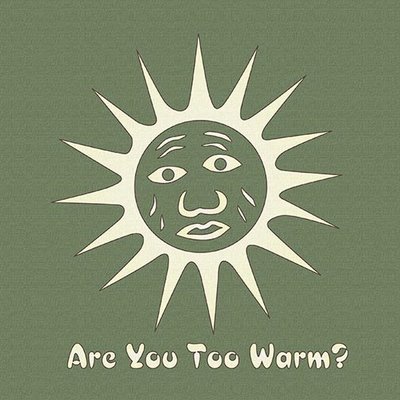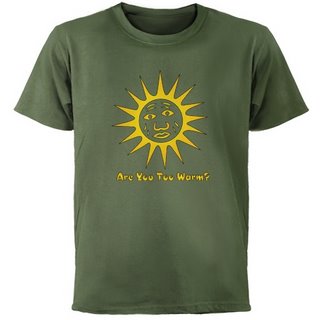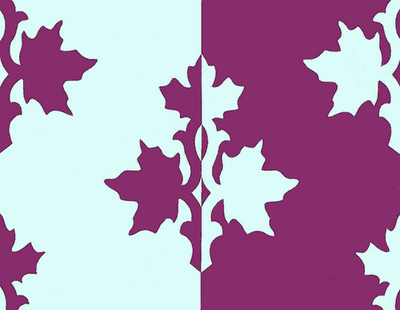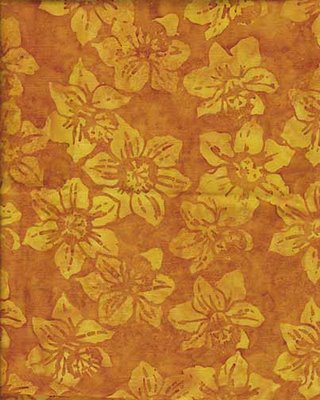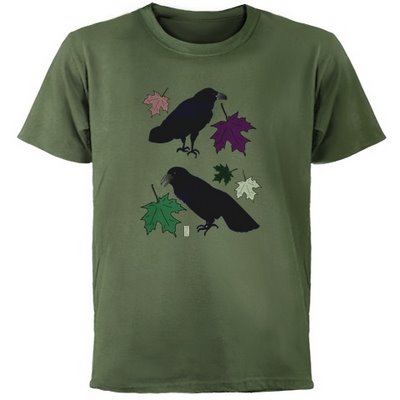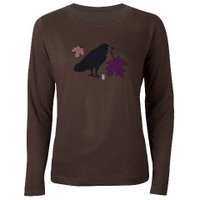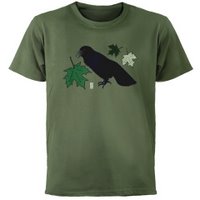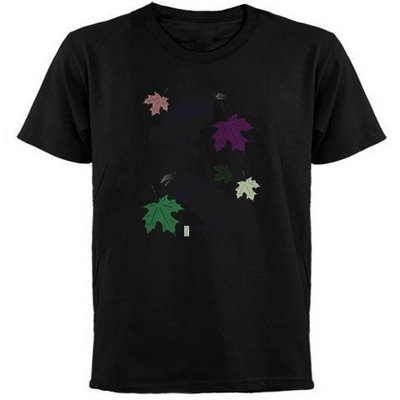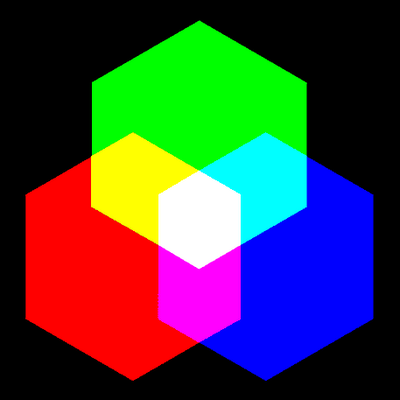
You are in a dark room. A beam of light reaches out to the white wall. It's green! Then another. It's blue! And where they overlap, twice as much light, twice as bright, and the color is called cyan. Sort of sky color. It's usually called turquoise in fabric dyes. Then another beam of light . Red! And it moves until it overlaps too. Where it overlaps the blue light, brighter than either, is a sort of purple-pink. You can see that it's a mix of blue and red. That color is called magenta in lights and printing inks, and usually fuschia in fabric dyes. Where the red overlaps the green light beam, twice as bright, is yellow. Sun color.
And in the center, where all the lights overlap, is white. The sum of all the 3 beams, Red, Green & Blue. Or the sum of any 2 opposites. Red light plus cyan light. Green light plus magenta light. Blue light plus yellow light. The sum of two complimentary lights is white light. The primary colors of light are Red, Green and Blue. The secondary colors (made by mixing 2 primaries) of light are Cyan, Magenta and Yellow. Those are also the primary colors of printing inks in the CMYK system, along with Black (K). The primaries of fabric dyes, equivalent to cyan, magenta, & yellow, are Turquoise, Fuschia, and Yellow. And in fabric dye, unlike inks, black is a mix of several colors.***
"But, but, but… That doesn't have anything to do with real life, does it? That's just an arbitrary system; It's only for computer screens, isn't it?" and "But, but, but… That isn't the color wheel we were taught in school! That can't be right. Blue wasn't opposite to yellow, was it? I'm sure red is opposite to green, not that funny magenta color. And where did that other blue come from? I'm sure red was opposite to green!" and, quietly, plaintively, "Why is the green so much brighter than the red and blue?" and maybe "Where's orange?" or "Why isn't there any real purple?"
This is the first of many posts about color. And I know I don't know everything, or even most things, about the subject. But to begin to address those questions — my first introduction to RGB color was in a classroom, with the scene described above. The Photomicrography teacher was shining colored lights at the wall. And when you see the light beams overlapping, and making those brighter colors, and then white, you have to start by admitting that this is real. This is the way the colors of light work.*
For years I thought of this as only an alternate color system, along with that system that was taught in school, with red, yellow & blue as the primaries, green, orange & purple as the secondaries. The paint-mixing color wheel. The "artists" color wheel. Because everyone was so dogmatic about how that was the "real" color wheel.
I made a color wheel based on the primaries of light, and used it for cross-stitch & quilt designs, and gardening. Because, if you compare them, you will see that this wheel expands the blue-to-green portion, and decreases the orange part. And first, I preferred it that way. And second, for garden designs, it seemed appropriate to expand the sky & leaves part of the wheel. But I was still thinking of this as just an alternate choice.
Then, I was working in a bookstore. And there are at least 2 books** out on color, from art house publishers, for artists, in which the writer is jumping up and down and waving his hands and shouting "Hey look eveybody! Look you guys! Look what I've found out! If you mix your paints starting with yellow, cyan & magenta instead of yellow, blue & red, as primary colors, you'll get much brighter colors!" As far as art education goes, or new books written on color, for quilters perhaps, this has mostly been ignored. But if you happen to take a college art course, and there happens to be a color wheel on the classroom wall, you may notice that although the primary colors are still labelled Yellow, Red & Blue — Red is definitely not fire engine red any more, but has migrated towards magenta, and blue is definitely not royal any more, but much more like cyan or turquoise. Unfortunately, they haven't redone the rest of the colors. The same orange, green and purple are still the secondaries. It makes the wheel look really unbalanced. But they are pretending, by renaming things, that they were right all along.
And on the question of what is real… Our eyes have rods and cones in the retina for detecting light. Rods work better than cones in low-light conditions, and detect only light to dark, or luminosity, not color. Cones are for detecting color. There are 3 kinds, the ones that detect Red, Blue or Green. Those primary colors of lights, Red, Green & Blue, are chosen because those are the primary colors of how our eyes detect color.****
And if the Red & Green cones react with equal intensity, we see yellow. (You were wondering how red & green added up to be yellow, weren't you?) And our eyes see most strongly in the yellow-green range (new-leaf color). So we see green light of the same intensity as brighter than red or blue.
And finally, all color wheels are figments of our imaginations. Light comes in wavelengths of the visible spectrum. Isaac Newton, who first described the spectrum of visible light, after splitting white light with a prism, named the colors he saw Red, Orange, Yellow, Green, Blue, Indigo & Violet. (Indigo, a dye, is the color of classic blue jeans. So the color he called blue is undoubtedly the bright cyan band which is very visible at the edge of the greens.) He put the colors back together into white light again by sending them through another prism. And he put the colors into a circle, adding purple, and made the first color wheel. He had to add purple (or red-violet) because it doesn't exist in the visible spectrum of light. Our eyes make the "non-spectral purples" by adding together other colors of light from the two ends of the visible spectrum of light.
If you're really interested in this, do see if your local college or community college has a Color Theory course. I guarantee it will expand your universe. And I hope you get a teacher as excellent as Pat Chapin, who was teaching it at our local community college, when I took color theory several years ago. And for books, be sure to look in the physics section as well as the art section of the library.
 Oh, new logo? Well I'm designing myself a website for the web design class, and I needed a logo. And doing that is what prompted me to start on this color explanation, finally.
Oh, new logo? Well I'm designing myself a website for the web design class, and I needed a logo. And doing that is what prompted me to start on this color explanation, finally.
*For photographers — you don't get the same effect by overlapping filters. Filters are taking away all but the selected color. When you overlap filters, you get only the light, if any, that isn't eliminated by either filter.
**Watson-Guptill published at least one of them, maybe both. I think one might have been about water color, one about oils. I think José Parramon might have written one of them. One of them went very thoroughly into the subject of afterimage colors, exploring just which exact shades were the visual opposites of a lot of colors. (For one set of eyes.)
***Dyes and inks are dependant on chemistry; either there is a single pigment which absorbs all wavelengths, making black, like charcoal, or there isn't. And if there isn't, like in fiber-reactive dyes, then blacks and grays are made by mixing several colors. So fiber reactive blacks will have a color cast, and color halos, as dye spreads in tie-dyeing. And if there are undissolved pigment spots, they might be red, in a grey with an overall greenish cast.
****Yes, psychological color has four primaries; red, green, blue & yellow. I'll study up on that, and see if I can explain it later. And no, not everybody's cones are the same. We don't all see the same red. More later.
Labels: color, design















